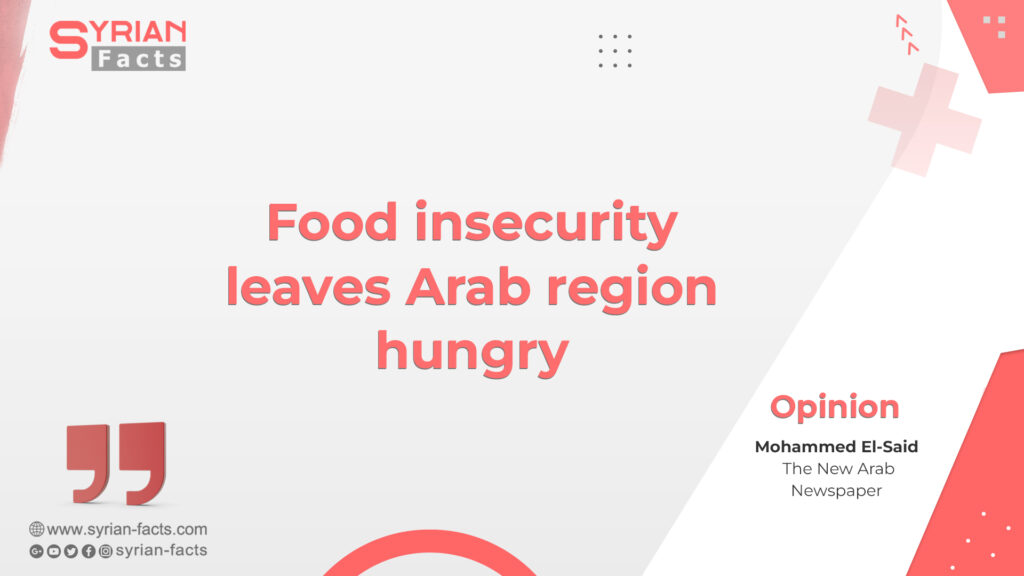Conflict, COVID-19, and climate change have left nearly 60 million Arabs hungry. Without reforming MENA’s agri-food systems, the region will remain at risk.
The number of undernourished people in the Arab region rose to 59.8 million people in 2022. This corresponds to 12.9% of the total population in the region, far exceeding the global average of 9.2%.
According to a recent UN report, this figure represents a 75.9% increase since 2000. The prevalence of hunger was highest in low-income and least-developed Arab countries, where almost a third of the population suffers from hunger.
Low-income and least-developed Arab nations had recorded the highest rates of hunger, with about one-third of the population suffering from malnutrition. Compared to non-conflict countries, undernourishment was nearly four times as common in conflict areas, according to the report 2023 Near East and North Africa Regional Overview of Food Security and Nutrition.
The report was jointly released on Tuesday, December 5 by the UN Food and Agriculture Organization (FAO); the UN Economic and Social Commission for Western Asia (ESCWA); the International Fund for Agricultural Development (IFAD); the UN Children’s Fund (UNICEF); the World Food Programme (WFP); and the World Health Organization (WHO).
External and internal challenges
Hunger can be defined as being unable to obtain food above the minimum dietary energy requirement for at least one full year. According to the FAO, the risk of hunger can be estimated by the average availability of calories, the equity of food distribution, and the minimum energy requirements.
“The increasing number, frequency, and extent of external and internal challenges have severely impacted the pursuit of food security in the Arab region,” said Abdelhakim El-Waer, Assistant Director-General of the UN Food and Agriculture Organization (FAO) and the organisation’s Regional Representative for the Near East and North Africa (NENA) region.
In 2022, 170.1 million individuals, or 36.6 percent of the population, experienced moderate or severe food insecurity; this represents a minor drop from 173.3 million people, or 37.9 percent of the population, who experienced food insecurity in 2021. However, acute food insecurity affected 61.0 million people in 2022. Since the previous year, there has been an increase of 3.8 million individuals.
As for the causes of the problem, El-Waer explains to The New Arab that conflicts represent the most significant reason for doubling the problem of hunger. The slow progress towards achieving the goals of the sustainable development plan regarding nutrition is also an important driver of food insecurity due to the weakness of food systems in the region.
He further explained that the region is also affected by climate change, and macroeconomic shocks such as the food price crisis, oil price volatility, declining tourism revenues, and health shocks such as the COVID-19 pandemic.
“Many factors exacerbate the problem, such as water scarcity, dependence on food imports, inequality, gender, rapid population growth, migration, and the shift in food systems associated with the move from rural to urban areas, which cast a negative burden on food systems and increase their vulnerability, Salwa Faried, Professor of Economics at Cairo University, told The New Arab.
A triple-burden
The report indicated that the Arab region suffers from a triple burden of malnutrition/undernutrition, child overweight/adult obesity, and micronutrient deficiencies, such as anaemia. The region recorded levels exceeding global averages in the prevalence of overweight among children (9.5%) and anaemia among women (33.2%).
Child stunting has also slowed, driven by rising food prices. According to the data, food price inflation has been a major driver of food insecurity in the region.
Palestine, Yemen, Syria, Sudan, and Somalia are the most vulnerable to the risks of hunger in the region due to wars and armed conflicts, as well as being affected by the effects of COVID-19 and climate change. Other countries such as Egypt, Jordan, and Lebanon are also suffering the economic consequences of COVID-19 and climate change impacts.
Abeer Etefa, the spokesperson for the WFP’s office in the MENA region, said that the resumption of Israel’s war in Gaza would undoubtedly exacerbate the catastrophic hunger crisis that threatens to increase the suffering of the civilian population. She told The New Arab that the WFP delivered food to more than 250,000 people in the Gaza Strip who were in dire need of it during the temporary truce period.
‘But the supplies that the program was able to bring in were completely insufficient to address the level of hunger seen by the relief team in the UN shelters,” she said.
Etefa warned of famine in Gaza, saying that “to avoid this, we must be able to bring food on a large scale and distribute it safely, and that the people of Gaza need food every day.
She pointed out that resuming fighting makes the distribution of aid almost impossible and puts the lives of humanitarian workers at risk. Above all, it is a disaster for Gaza’s civilian population of more than two million, who are completely dependent on food aid.
As for Yemen, the WFP announced the cessation of public food distribution operations in areas under the control of the authorities in Sana’a after a full year of negotiations failed to reach an agreement with the authorities to give priority to the most vulnerable population groups facing the risk of hunger with available funding.
In Syria, conflicts, the climate crisis, and economic instability have put unprecedented pressure on the world’s food systems, exacerbating hunger and malnutrition in many regions.
Urgent measures
The report calls for an urgent strategy for the region to reform its agri-food systems to make them more resilient to shocks and impending crises, as well as more efficient, inclusive, and sustainable to meet the targets outlined in Sustainable Development Goal 2 to fight hunger and reverse the declining trends in food security and nutrition.
The second goal of the 17 UN Sustainable Development Agenda calls for eliminating hunger, ensuring that everyone, especially the poor and vulnerable groups, including infants, has access to safe and nutritious food all year round, and ending all forms of malnutrition by 2030.
“We need to accelerate the transformation of agri-food systems, ensure sustainability and resilience through collaborative and transformative leadership and policies, and adopt more creative and climate-smart solutions,” El-Waer said.
As for Gaza, the WFP stressed that humanitarian workers must have safe, sustainable, and unhindered access to be able to distribute aid throughout the Gaza Strip.
The New Arab Newspaper









Be the first to write a comment.